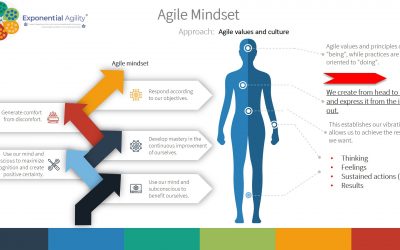In a highly ambiguous, complex and uncertain business environment, an agile strategic approach is the key to effective and efficient management.
An agile strategy is a “set of practices”, to incorporate in the way in which our company continuously adapts to a rapidly changing world, it is about continuously driving change.
The agile strategy concept describes the ability of an organization to remain flexible and fluid, continually changing and updating its operations through new innovations.
Technology and globalization have been elements of change, have made the internal value chain disaggregate, disintegrate.
Organizations need to move faster and independently.
The change disruptor is a continuum, it is a recursive framework, a living artifice and constantly redefining itself and change within the organization to adapt to the environment quickly.
“Transformation means that you are really” fundamentally changing the way the organization thinks, “the way it responds, and the way it leads.”
Strategic agility isn’t about traditional reorganization, it’s about transformation.
For strategic agility to exist, it is necessary to commit to investments in the following elements, asking ourselves the following questions:
- Centrality in the client.
- Are the objectives based on core needs?
- Organic and autonomous approach.
- Is there collaboration between the organization’s collaborators to carry them out?
- Build the foundation for meaningful and healthy interactions.
- Are teams empowered to execute decisions?
- Fast learning and experimentation.
- Can decisions be tested quickly?
The organizational parameters defined by the traditional strategy have not changed much in an agile strategy, they are integrated as by: the vision, mission, values, accompanied by a set of financial objectives, an operational plan or road map, it is executed regularly with a 3-5 year perspective.

Figure 1: Spaceship that took us to the moon (* Moonshot Thinking).
* Moonshot Thinking is when we choose a big problem and propose to create a radical solution to the problem using disruptive technology. Also, a shot to the moon targets a 10 times greater impact on problems, not just a 10% improvement.
In a highly volatile market, which changes rapidly, the rhythm or metabolism of the company must be greater or equal in its speed, this realizes that a new norm is emerging. The objectives of the strategy may have remained the same, but your methods must now change.
The most notable differences of an agile strategy framework with a traditional one are delimited by the “how” it is done, based on Fernando, R (2019), are the following:
Approach: Developing the strategy becomes a framework, not a process. A framework is an entity between a model and a method. A framework is a structure, or system, for the realization of a defined result or objective.
Shifting priorities: strategic priorities shift from a set of goals to a dynamic horizon, the place where market opportunities meet organizational capabilities.
Iterative approach: Long-term strategies can never be taken for granted. Therefore, all domains of the strategic lifecycle must be iterative.
Pace and flexibility: given the dynamic nature of this horizon, the strategic pulse of the organization beats monthly and quarterly instead of annually or every two years, which generates a greater response capacity, this means that the metabolism of the organization.
Progress and results: The objective is to obtain a greater response capacity in highly dynamic markets. Instead of tracking lagging or traditional indicators, you need to create leading indicators.
Team: The agile strategy team is now a multidisciplinary team that crosses the organization, levels, functions and organizational limits, it is a team that executes agile with agile.
Thanks for reading this articule.
Miguel Martínez, 03/03/2021
Bibliographic references:
- Ismail, I., Palao, F., y Michelle, L. (2019). Transformación Exponencial. México D.F.: Bubok Publishing SL.
- Lyngso, S. (2014). Agile strategy management: Techniques for continuous alignment and improvement. Boca Raton: CRC Press.
- Fernando, R. (2019). Agile strategy: How to create a strategy ready for anything. Harlow, England: Pearson.
- Lambert, D. (2020). Practical Guide to Agile Strategy Execution: Design, Architect, Prioritize, and Deliver your Corporate Future Successfully. CA: Independently published.
- Wiraeus, D., y Creelman, J. (2019). Agile strategy management in the digital age: How dynamic balanced scorecards transform decision making, speed and effectiveness. Cham, Switzerland: Palgrave Macmillan.
- Porter, D. T., y Porter, M. E. (2015). Estrategia competitiva: Técnicas para el análisis de los sectores industriales y de la competencia. México D.F.: Grupo Editorial Patria.



